Is radon a scare tactic? With this question looming, we embark on an intriguing journey to unravel the truth about radon, its potential health risks, and the prevalence in homes. Join us as we delve into the fascinating world of radon and uncover the facts that lie beneath the surface.
Radon, an invisible and odorless gas, has gained significant attention due to its potential health hazards. As the second leading cause of lung cancer, understanding the risks associated with radon exposure is crucial. Radon seeps into homes through cracks in foundations and walls, posing a threat to unsuspecting occupants.
Introduction: Is Radon A Scare Tactic
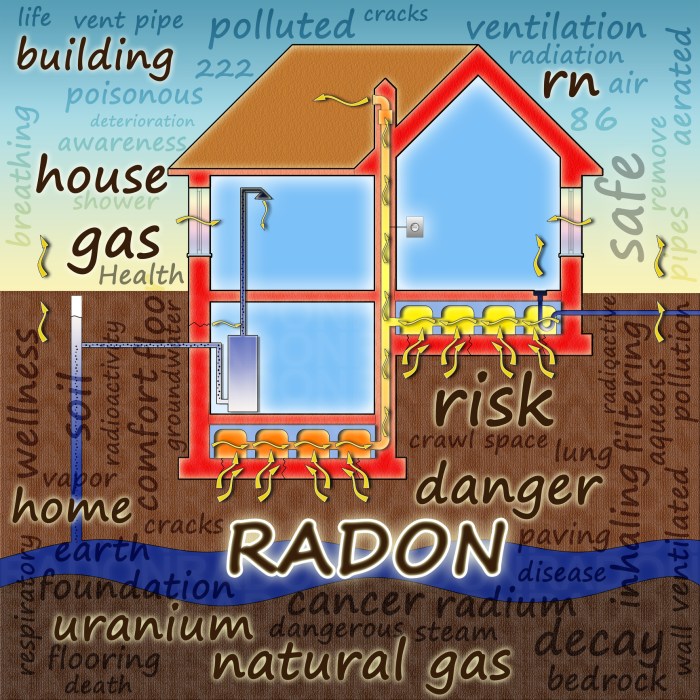
Radon is a naturally occurring radioactive gas that can accumulate in homes and other buildings. It is a known carcinogen, and exposure to radon has been linked to an increased risk of lung cancer.
Radon is found in the soil and can enter homes through cracks in the foundation or other openings. The gas can also be released from building materials, such as concrete and brick.
Prevalence of Radon in Homes
Radon is a common problem in the United States. The Environmental Protection Agency (EPA) estimates that one in every 15 homes in the country has radon levels that are high enough to pose a health risk.
Radon levels can vary significantly from home to home, even within the same neighborhood. This is because the amount of radon that enters a home depends on a number of factors, including the type of soil, the construction of the home, and the ventilation system.
Impact of Radon on Public Health
Radon is the second leading cause of lung cancer in the United States, after smoking. Exposure to radon is estimated to cause about 21,000 lung cancer deaths each year.
Radon exposure is a particular concern for children, who are more susceptible to the effects of radiation. Children who are exposed to radon have an increased risk of developing lung cancer later in life.
Radon Measurement and Mitigation
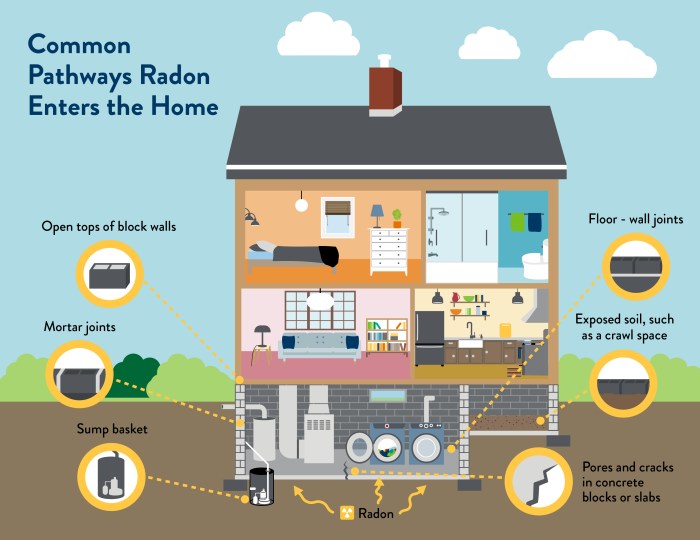
Radon measurement and mitigation are essential steps in protecting homes and their occupants from the health risks associated with radon exposure. Understanding the methods used to measure radon levels and the available mitigation techniques is crucial for effective radon management.
Radon Measurement
Measuring radon levels in homes is typically done using two main methods:
- Short-term test:This test, usually lasting 2 to 7 days, provides a quick and inexpensive estimate of radon levels.
- Long-term test:This test, lasting 90 days or more, offers a more accurate representation of year-round radon levels, considering seasonal variations.
Radon Mitigation
Radon mitigation involves techniques to reduce radon levels in homes to acceptable levels. Common methods include:
- Sub-slab depressurization:This method involves installing a system that draws radon-contaminated air from beneath the foundation and vents it outdoors.
- Air-to-air heat exchanger:This system brings fresh outdoor air into the home and exhausts radon-contaminated air, effectively diluting radon levels.
- Sealing cracks and openings:Sealing gaps and cracks around pipes, windows, and doors can prevent radon from entering the home.
Costs and Effectiveness
The cost of radon mitigation varies depending on factors such as the size of the home and the mitigation method used. However, the investment in radon mitigation can significantly improve indoor air quality and protect occupants from the health risks associated with radon exposure.
Radon and Real Estate
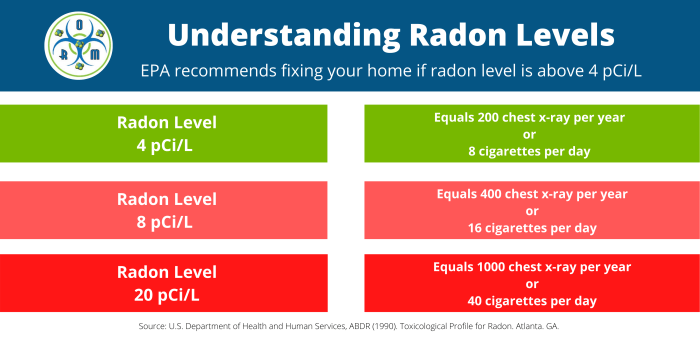
Radon testing has become an integral part of real estate transactions, as it helps ensure the health and safety of future occupants. Understanding the role of radon in real estate is crucial for both buyers and sellers.
Impact on Home Values and Marketability
Elevated radon levels can significantly impact home values and marketability. Homes with high radon levels may be difficult to sell or may sell for less than comparable homes with lower levels. Disclosing radon levels to potential buyers is essential, as it can influence their decision-making process.
Guidance for Buyers
Before purchasing a home, it’s highly recommended to conduct a radon test. This test will provide an accurate measurement of radon levels and help you make an informed decision. If radon levels exceed the recommended limits, it’s essential to consider mitigation options to reduce exposure.
Guidance for Sellers
Sellers should disclose any known radon levels to potential buyers. This transparency helps build trust and demonstrates a commitment to the health and safety of the property. If radon levels are elevated, sellers may consider radon mitigation before listing the home for sale.
This can enhance the home’s value and make it more attractive to buyers.
Radon Awareness and Education
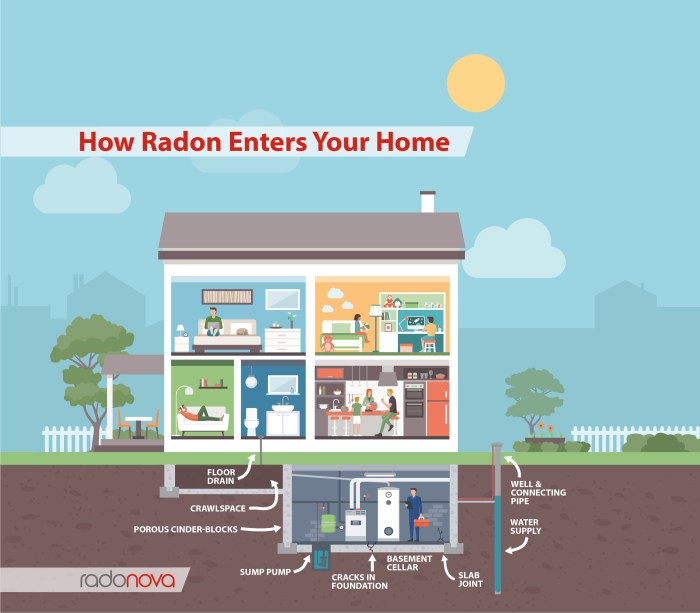
Raising awareness about radon and its health risks is crucial for protecting public health. Governments, public health organizations, and various initiatives play a vital role in educating individuals about radon and promoting actions to mitigate its risks.
Government Agencies
- The Environmental Protection Agency (EPA) has established the National Radon Action Program, providing resources and guidelines for radon testing and mitigation.
- The Centers for Disease Control and Prevention (CDC) publishes comprehensive information on radon health effects and recommends testing and mitigation strategies.
Public Health Organizations
- The American Lung Association conducts public education campaigns, provides radon testing kits, and advocates for radon mitigation policies.
- The National Radon Safety Board offers certification programs for radon professionals and promotes industry standards.
Resources for Individuals, Is radon a scare tactic
- The EPA’s website provides extensive information on radon, including testing guidance, mitigation techniques, and resources for homeowners and renters.
- State and local health departments often offer radon testing programs and educational materials.
- Radon measurement and mitigation professionals can provide personalized advice and services to address specific radon concerns.
Radon and Building Codes
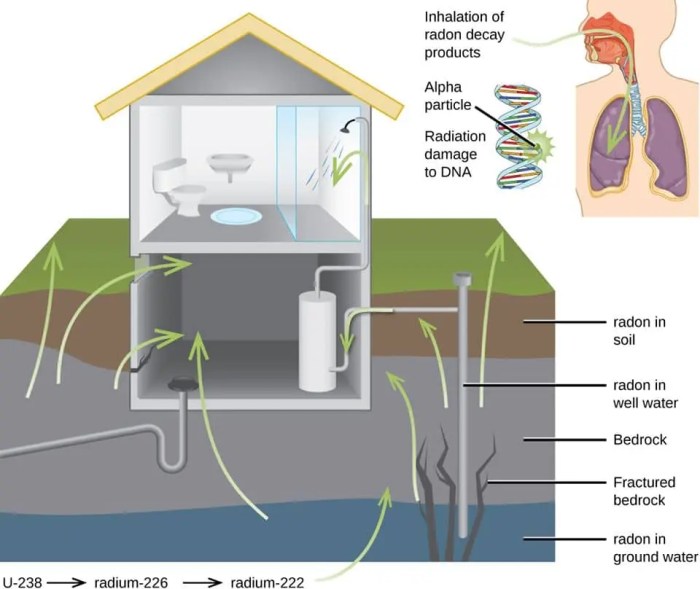
Building codes are regulations that establish minimum standards for the construction and maintenance of buildings. The inclusion of radon testing and mitigation requirements in building codes is an important step towards reducing radon exposure and protecting public health.
Is radon a scare tactic? Some people believe it is, but there is plenty of evidence to suggest that it is a real threat. Just like the movie Boyz in the Hood showed the harsh realities of life in South Central Los Angeles, radon exposure can have serious consequences for our health.
Several states and municipalities have adopted radon-related building codes. For example, the state of Pennsylvania requires radon testing in all new homes and buildings. The city of Denver, Colorado, requires radon mitigation in all new homes and buildings that are located in areas with high radon levels.
Benefits of Incorporating Radon Measures into Building Codes
- Protects public health:Radon exposure is a leading cause of lung cancer. Radon testing and mitigation can help to reduce radon exposure and protect public health.
- Saves lives:Radon-related lung cancer is preventable. By incorporating radon measures into building codes, we can save lives.
- Reduces healthcare costs:Radon-related lung cancer is a costly disease to treat. Radon testing and mitigation can help to reduce healthcare costs.
Challenges of Incorporating Radon Measures into Building Codes
- Cost:Radon testing and mitigation can be expensive. This can be a barrier to incorporating radon measures into building codes.
- Lack of awareness:Many people are not aware of the dangers of radon exposure. This can make it difficult to get support for incorporating radon measures into building codes.
- Enforcement:Building codes are only effective if they are enforced. This can be a challenge, especially in areas with limited resources.
Despite these challenges, incorporating radon measures into building codes is an important step towards reducing radon exposure and protecting public health.
Radon and Public Health Policy

Radon exposure poses significant public health concerns, necessitating the involvement of government agencies in regulating radon levels and safeguarding public health.
At the federal level, the Environmental Protection Agency (EPA) has established guidelines for acceptable radon levels in homes and workplaces. The EPA recommends that indoor radon levels not exceed 4 picocuries per liter (pCi/L). Several states have adopted these guidelines or established even stricter limits.
State and Local Regulations
Many states have implemented radon regulations that require testing and mitigation in certain situations. For example, some states mandate radon testing in all homes before they are sold or rented. Others require radon mitigation systems to be installed in homes with elevated radon levels.
Local governments also play a role in radon regulation. Some cities and counties have adopted radon ordinances that supplement state regulations. These ordinances may require radon testing in all new construction or in homes located in areas with high radon potential.
Strengthening Public Health Policy
While existing radon regulations have made significant progress in reducing radon exposure, there is still room for improvement. Public health policy could be strengthened in several areas:
- Expanding Radon Testing:Require radon testing in all homes, regardless of location or age.
- Improving Mitigation Techniques:Develop and promote more effective and affordable radon mitigation methods.
- Enhancing Public Education:Increase public awareness about radon exposure and the importance of testing and mitigation.
By strengthening public health policy, we can further reduce radon exposure and protect the health of our communities.
FAQ Resource
Is radon a significant health risk?
Yes, radon is the second leading cause of lung cancer in the United States.
How can I test for radon in my home?
Radon testing kits are available at hardware stores and online. Follow the instructions carefully to ensure accurate results.
What are the recommended radon levels in a home?
The Environmental Protection Agency (EPA) recommends radon levels below 4 picocuries per liter (pCi/L) of air.